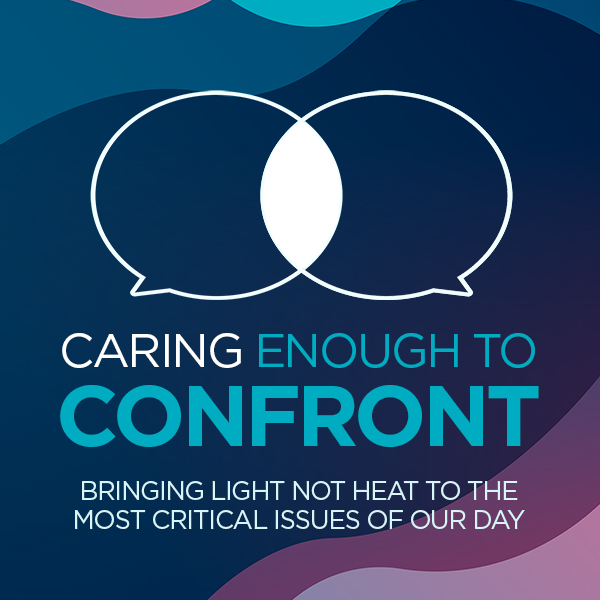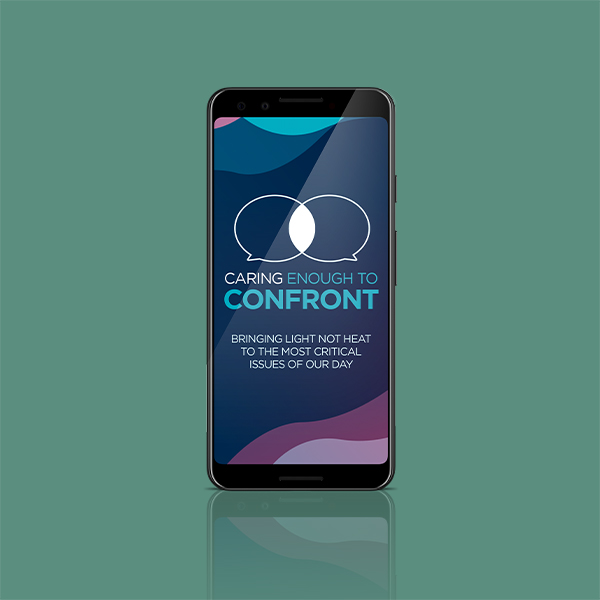daily Broadcast
Transgender Issues and The Bible, Part 1
From the series Caring Enough to Confront
Male. Female. Gender. What do these terms mean in the context of our changing society? In this program, guest teacher Pastor Tim Lundy focuses on the newest and probably most complicated aspect of today’s sexual ethic: transgenderism. Hear what the Bible says about this pressing issue that is impacting countless families everywhere.

About this series
Caring Enough to Confront
Bringing Light Not Heat to the Most Critical Issues of Our Day
Our world right now can be characterized by one word - divided. There is a dangerous us vs. them mindset out there that is invading every aspect of society. Unfortunately, even in the name of holiness, Christians have begun thinking this way, too. So, when confronted with the hot-button issues of our day, how should followers of Jesus respond? In this vital series, we will better understand what it means to be salt and light. Join us as we explore what the Bible says about topics like abortion, politics, and sexuality and how we are to lead with grace and truth when we engage those with different beliefs.
More from this seriesMessage Transcript
As Christians, our approach to sex and gender must be marked by grace and truth. It’s got to be marked by grace and truth. That’s how Jesus came. He was a man full of grace and truth. And He extended grace to all people no matter where they are coming from.
I want you to hear this explicitly from me. No matter where you’re coming from, no matter what you have done, no matter even if you disagree with me, man, the grace of Jesus Christ is for all people. But He is also a man of truth. That He recognized that lies kill people.
In fact, remember how He talked about Satan and He talked Himself? He says, “The evil one comes to lie and kill and destroy.” He loves killing life. “But I came to bring the truth,
because truth sets you free.”
Now, particularly on this issue, when we approach transgender issues, we need to protect against the ideology while still caring about the individual. I would say when it comes to this transgender movement, it’s easy for us at times to maybe over speak or to react in certain ways. And we’ve got to hold this balance.
I love how Jesus did it. Notice what He said. He said, “I am the good Shepherd; the good Shepherd lays down His life for His sheep. The hired hand is not the shepherd, he does not own the sheep. So, when the wolf is coming he abandons the sheep and runs away and the wolf attacks the flock and scatters it.” Jesus said, I am such a good Shepherd, I protect My own. I protect My sheep. When any wolf comes in, anybody comes in whether it's an ideology, whether it’s a lie, whether it’s anything that the evil one wants to do, Jesus stands full front and He says, I protect My own.
So, He protected His own. But He was also the same Savior that always went after the one, no matter where they had gone, no matter what they were struggling with. And so, as we talk about this today, there will be places I need to speak truth strong and you need to feel that, but in the same way, today, you might be the one here who is struggling.
And you need to know that there is a Savior that we serve, the reason we are so crazy about Him, the reason we align our lives to this Bible, is He goes after everyone and He makes a difference for everyone.
So, as we say that, let me jump in with some terms. And again, I’m a little wary to do this because there are so many terms. And I’ll just say right at the outset I have simplified it in some ways. Now, I think that’s part of the strategy of the evil one. He wants to confuse us and so he has created a thousand categories of everything in confusion. There are a few simple terms that you need to grab as you jump in this.
Alright, the first one is sex. And let me be clear. For the rest of this message, when I use the term “sex” I am not talking about having sex, okay? I’m not. I’m not talking about the act of sex, I’m talking biological sex. Okay?
So, it refers to a person’s biological status and is typically categorized as male, female, or intersex. So, every person is categorized, your body, and it used to be it was pretty simple. When you had a baby, what did the doctor declare? “It’s a boy!” “It’s a girl!” Now that’s no longer the case. It’s called: you were assigned at birth. In other words, the doctor may say that about you but that’s not who you really are. You see the shift in thinking with that?
And so, biological sex is your body. Now, intersex, there’s a rare condition and it’s rare. Again, I keep seeing numbers, one of the strategies of this current movement is try to spike numbers and things that are not as high as they are spiking.
But there is, there’s a condition of those who have both male and female, sometimes body parts, sometimes chromosomes in that, it goes across a spectrum in that. It’s very rare, it does not prove transgender, and almost all intersex people live a binary life. In other words, they live either as a male or a female. It would actually support that.
And so, when you talk about sex, your body is either a man or a woman. Now, you can change parts of your body. You can have surgery, you can alter parts, but it was interesting to me, you know, Dr. Alice McGregor she’s an emergency room doctor, she said when someone comes in, she did a lecture on this, when somebody comes in, you have to know as a doctor no matter what they have done, are they a man or a woman? Because your biological sex is expressed down to the cellular level, down to the cellular level.
And so, whether you have changed that or not, your body is still that, according to science, if you’re just going to start there.
Now, here’s the second - and here’s where it gets confusing - gender is the psychological, social, and cultural aspects of being male or female. So, it’s how my brain views myself, psychologically. Do I view myself, even though I may have a male body, do I view myself at a brain level as male?
Social and cultural, and this is where stereotypes come in and have been actually been damaging both in the Church and outside in culture where we create a stereotype of what it means to be a man and all men like certain things and all women act certain way out of that. And so, if somebody has confusion around that, where they look at it and they go, “Well, I don’t match up to that,” well, “I don’t really match there.” Or, “I don’t feel that way.”
Gender dysphoria is the distress some people feel when their internal sense of self doesn’t match their biological self. So, whether at a brain level or an internal level, I may be biologically male, but I don’t feel male. And so, I don’t identify as male or I don’t identify as female.
And this term “gender dysphoria,” it’s actually a pretty recent term. The term itself, it comes from the diagnostic manual. So, the Diagnostic and Statistical Manual of Mental Disorders, a medical manual that is used. Up until 2013, this was called “gender identity disorder.” And it was treated as a disorder. And so, medically how do we treat the disorder? And then it has been changed since 2013, so that there’s no stigma, it’s called gender dysphoria. It’s not conclusive of how it happens.
Some have studied the SRY gene and where it attaches, which chromosome it attaches to can have some impact. Some have studied a wash of testosterone that happens later in the pregnancy. And so, boys that did not get that wash of testosterone, or little girls that did get it, that can impact the brain, impact the wiring in different ways. It can be culturally created, sometimes it’s based on trauma.
You know, Dr. Mark Yarhouse, when he talks about transgender, he’s a Christian psychiatrist, he says, “If you have ever met one transgender person you have met one transgender person.” And this would be his point, because he works so much with people that he says, “You can’t just assume that, you know, I’m just going to do this broad category.”
And so, when you look at that, the categories around that, there’s kind of three times that it shows up with it. Early onset – it’s really two times and then one subcategory. Early onset: little children, prepubescent – I mean, as early, three to six years old can express some confusion around this. And so, that’s what you’re hearing about in culture today, that early onset, and so they’re immediately putting hormone blockers and treating it with that.
Now here’s the problem with that. Debra Soh in her book The End of Gender, somewhere between sixty to ninety percent, depending on the study, if the child is left alone, if the gender that matches their body is actually affirmed, sixty to ninety percent of the time, it just goes away.
Now, you’re not hearing that today. You’re hearing today, “No, you’ve got to intervene immediately, you’ve got to do something, you…” That’s not true. And so, as a parent, you don’t need to reach a panic point. Little kids can be confused. Little kids can have questions.
Now, for those that it continues with that, it is the ongoing gender dysphoria. And so, we’ve got to be careful we don’t just write it all off with that. But we don’t have to overreact in the same way the culture does in the certain movement. Some, it’s a later adolescent onset. Here’s the newest, this rapid onset gender dysphoria.
In the last six or seven years, you are seeing this spike, especially among teenage girls at a rate that doesn’t match anything else in the population. And so, if somebody were to say, “Well, we are just accepting it more now,” then you would see the same rate across the population. I’m talking like a spike of four thousand to five thousand percent.
But this is a pretty radical movement that, frankly, one, is destroying so many lives. And two, it’s actually hurting people that really do have gender dysphoria, that need help.
So, then when you talk about transgender, this is the umbrella term that describes people whose gender identity or expression does not match the sex they were assigned at birth. So, trans means to cross over. Cis means to be on the same side. So, if you’re called “cisgender” that means that your biological sex and your gender, they both match.
Transgender is someone who they have chosen a gender identity or a gender expression that doesn’t match their biological sex. And it can be a number of different ways. Again, I told you, there’s a spectrum out of that. For some it’s just changing clothes and dressing differently. For some it’s taking on characteristics. Some move to medical treatment, whether it’s a hormone or other treatment. Some move to surgery. Very few move to complete surgery.
And so, again, when you use the term “transgender” it’s a very umbrella term and you have to be careful that you are speaking to the person and not just the movement. Now, I know that’s a lot of terms coming at you fast, but I wanted to give you the lay of the land. Now I am going to go even faster, because we are going to look at what the Bible says about it.
And every one of these verses, I can probably do a sermon. That’s not the point today. I just want to give you a biblical overview; what does the Bible say? The problem with it is there’s no place in your biblical concordance that you can type in the word “transgender” and you go, “Oh, there’s all the verses with transgender in it.” That doesn’t mean the Bible doesn’t speak to it, because the Bible has a lot to say about our bodies and it has a lot to say about our sexuality and a lot to say about our identity.
So, what does it have to say? Let’s walk through this together. What does the Bible say? And I would say on this, because I’m moving fast out of this, these categories, I took them straight out of one of the chapters in Preston Sprinkle’s book. I say that so that you know I’m not plagiarizing. I’m not trying to plagiarize. I just used his categories off of it.
The first thing, the body is essential to our image-bearing status. We are image bearers of God. Genesis 1:27, “God created man in His own image, in the image of God He created him, male and female He created them.” In fact, that word image, it’s also the root word for idols. So, when the false cults wanted to show representation of their gods, they made idols.
When God wanted to show representation of Himself on this planet, what did He choose to do? He chose humanity. And He didn’t choose us to be a spirit or spirit forces. He gave us bodies. They are really important to the expression of the full image of God, both male and female were important to that.
Male and female in Genesis 1 are categories of sex, not gender. So, when they used the term “male and female” he’s not talking about genders, he’s talking about their sex. And so, there’s not a de-linking there. Look at it, the very next verse. “God blessed them and He said to them, ‘Be fruitful and multiply; fill the earth and subdue it.’” One of the core things that they needed to do with their body is actually have sex so that they could fill the earth.
The third thing that we see out of this, Adam and Eve’s bodies are viewed as sacred. When Eve was created, and we often talk about, you know, He put Adam to sleep and He took one of his ribs. The word there literally means “side.” And it’s interesting, this word in Hebrew, sela, it’s usually presented, in fact, almost every other reference you’ll see it, it talks about the side of a sacred building, like a temple or the tabernacle.
From the very beginning we were created to be temples, our bodies are temples. In fact, you see it again in the New Testament, what does Paul emphasize to us? “Don’t you know your body is a temple of the Holy Spirit?” this sacred function of the body from the very beginning.
Jesus’ views of Genesis 1 and 2 are normative. So when Jesus is asked about this, what does He do? He quotes this passage. Here we are thousands of years later, this is what Jesus was referring to. And so, if you want to go, “Yeah, okay, that was the Old Testament, but what did Jesus say?” This is what Jesus said. And He went back to that because it was so important.
Paul sees the body as significant for moral behavior and correlates the body to personhood. I’ve talked to you about, in Corinth, there was every form of sexual expression and one of the problems they had in the Church is often people would go see prostitutes, because they didn’t consider prostitute sex as sex, sex. Because there’s no emotional engagement. I mean, it’s just, you know, you are paying for it. It’s about the lowest form.
And Paul says, “Yeah, but do you not know that your body is the temple of the Holy Spirit…you are not your own, you were bought with a price. Glorify God with your body.” That’s why he says in Romans 12, “Present your body,” all of who you are, “as a living sacrifice.” Because your bodies matter.
Scripture prohibits cross-sex behavior. And so, if you look at in Deuteronomy 22:5, “A woman shall not wear a man’s garment, nor shall a man put on a woman’s cloak, for whoever does those things is an abomination to the Lord your God.”
Now, again, we talked about the complexities of dipping back into the Old Testament Law. But what are those principles are one just ceremony to Israel, what are those principles that are teaching us moral standards that still apply?
And in 1 Corinthians 11, Paul, when he references this same thing about what women wear, it’s referencing those same principles. It’s not just the garment itself. In fact, in the Hebrew, the word there is “men’s things,” or, “women’s things.” And so, it’s this prohibition of aligning your life to live, or to adorn, or to present yourself as the opposite sex of what you are.




